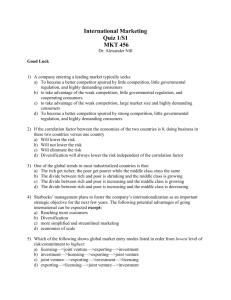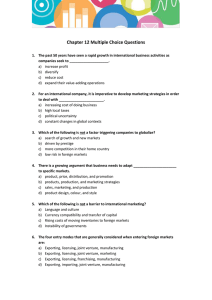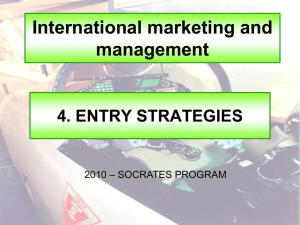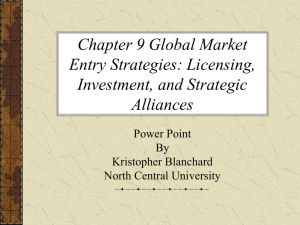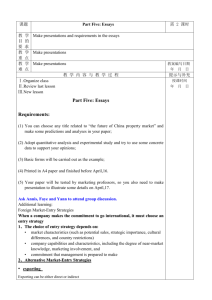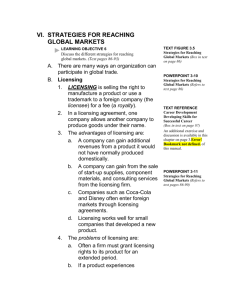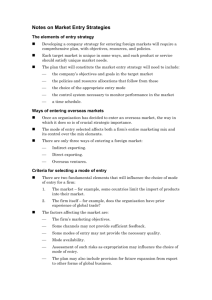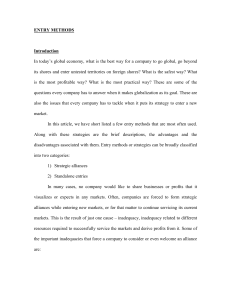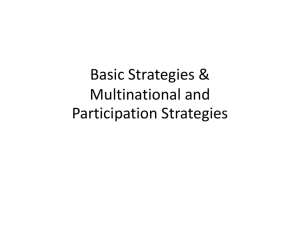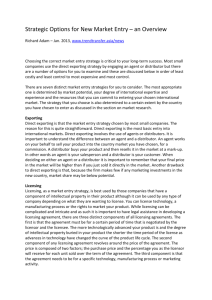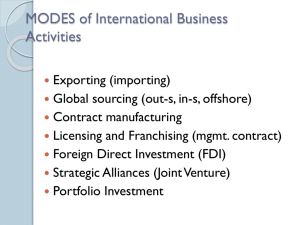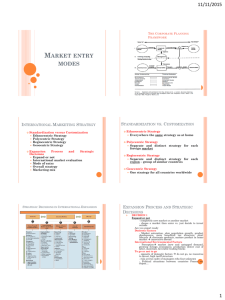CHAPTER 2:
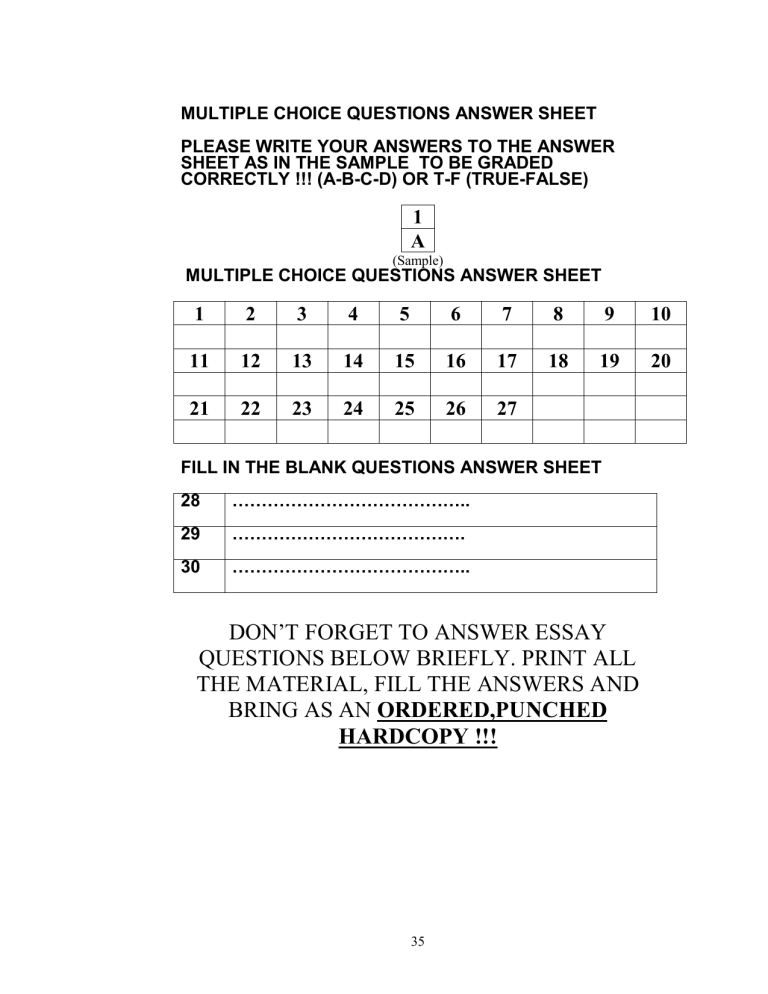
MULTIPLE CHOICE QUESTIONS ANSWER SHEET
PLEASE WRITE YOUR ANSWERS TO THE ANSWER
SHEET AS IN THE SAMPLE TO BE GRADED
CORRECTLY !!! (A-B-C-D) OR T-F (TRUE-FALSE)
1
A
(Sample)
MULTIPLE CHOICE QUESTIONS ANSWER SHEET
1 2 3 4 5 6 7 8 9 10
11 12 13 14 15 16 17 18 19 20
21 22 23 24 25 26 27
FILL IN THE BLANK QUESTIONS ANSWER SHEET
28 …………………………………..
29 ………………………………….
30 …………………………………..
DON’T FORGET TO ANSWER ESSAY
QUESTIONS BELOW BRIEFLY. PRINT ALL
THE MATERIAL, FILL THE ANSWERS AND
BRING AS AN ORDERED,PUNCHED
HARDCOPY !!!
35
WORKSHEET 3
CHAPTER 3
COMPETING IN THE GLOBAL ECONOMY
READ THE FOLLOWING VERY CAREFULLY
PLEASE DO THE FOLLOWING TEST AND
ANSWER THE ESSAY QUESTIONS (50 POINTS )
Learning Objectives
1.
Define what business is and identify four key social and economic roles that businesses serve
2.
Differentiate between goods-producing and service businesses and list five factors that are contributing to the increase in the number of service businesses
3.
Differentiate between a free-market system and a planned system
4.
Explain how supply and demand interact to affect price
5.
Discuss the four major economic roles of the U.S. government
6.
Explain how a free-market system monitors its economic performance
7.
Identify five challenges that businesses are facing in the global economy
Summary of Learning Objectives
1.
Highlight the opportunities and challenges of conducting business in other countries.
Conducting business in other countries can provide such opportunities as increased sales, operational efficiencies, exposure to new technologies, and consumer choices. At the same time, it poses challenges such as the need to learn unique laws, customs, and ethical standards. Furthermore it exposes companies to the risks of political and economic instabilities, volatile currencies, international trade relationships, and the threat of global terrorism.
2. List five ways to improve communication in an international business relationship.
To improve international communication, learn as much as you can about the culture and customs of the people you are working with; keep an open mind and
36
avoid stereotyping; anticipate misunderstandings and guard against them by clarifying your intent; adapt your style to match the style of others; and learn how to show respect in other cultures.
3.
Identify five forms of international business activity.
Importing and exporting, licensing, franchising, strategic alliances and joint ventures, and foreign direct investment are five of the most common forms of international business activity. Each provides a company with varying degrees of control and entails different levels of risk and financial commitment.
4.
Discuss why nations trade.
Nations trade to obtain raw materials and goods that are unavailable to them or too costly to produce. International trade benefits nations by increasing a country’s total output, offering lower prices and greater variety to its consumers, subjecting domestic oligopolies and monopolies to competition, and allowing companies to expand their markets and achieve production and distribution efficiencies.
5.
Explain why nations restrict international trade and list four forms of trade restrictions.
Nations restrict international trade to boost local economies, to shield domestic industries from head-to-head competition with overseas rivals, to save specific jobs, to give weak or new industries a chance to grow strong, and to protect a nation’s security. The four most commonly used forms of trade restrictions are tariffs (taxes, surcharges, or duties levied against imported goods), quotas
(limitations on the amount of a particular good that can be imported), embargoes
(the banning of imports and exports of certain goods), and sanctions (politically motivated embargoes).
6.
Highlight three protectionist tactics nations use to give their domestic industries a competitive edge.
From time to time countries give their domestic producers a competitive edge by imposing restrictive import standards such as requiring special licenses or unusually high product standards, by subsidizing certain domestic producers so they can compete more favorably in the global marketplace, and by dumping or selling large quantities of a product at a lower price than it costs to produce the good or at a lower price than the good is sold for in its home market.
7.
Explain how trading blocs affect trade.
Trading blocs are regional groupings of countries within which trade barriers have been removed. These alliances ease trade between bloc members and strengthen barriers for nonmembers. Critics of trading blocs fear that as members become more protective of their regions, those not in the bloc could suffer. Proponents see them as a way to help smaller or younger nations compete with producers in more developed nations. The four most powerful trading blocs today are the Association of Southeast Asian Nations (ASEAN), the Mercosur, the North American Free Trade Agreement (NAFTA), and the
European Union (EU).
37
8.
Discuss terrorism’s impact on globalization
Terrorism could prompt companies to withdraw from the global marketplace and focus more on doing business within their national borders. But the likelihood of moving in that direction is remote. Most multinational organizations have too much at stake to move backwards; they see globalization as the key to their future. Global terrorism, however, does pose new challenges to world trade. Tighter security, border crossing delays, cargo restrictions, and higher transportation costs are impacting the free flow of goods in the global marketplace. These obstacles are forcing some companies to rethink their inventory and manufacturing strategies.
MULTIPLE CHOICE QUESTIONS
1. Which of the following is NOT a potential advantage of engaging in international trade? a) Exposure to new technologies
b) Homogenous workforces and markets c) Increased sales d) Operational efficiencies
2 All of the following are forms of international business activity EXCEPT: a) Importing and Exporting b) Joint ventures c) Devaluation d) Licensing
3- A company that buys products for resale overseas and that performs other importing and exporting functions is called a(n) ______ . a) Franchiser b) Licenser c) Export management company d) Export trading company
4-Claire agrees to let a British company produce and market her women's gardening gloves in England for a fee. This approach to international business is known as which of the following? a) Exporting b) Franchising c) Joint venturing d) Licensing
5-Many companies choose licensing because ______. a) It is the risky form of global business b) It involves little of the business’s money c) The companies involved have a long-term equal partnership d) Both firms join together to create a new business
38
39
6-When KFC gives the rights to a business to duplicate its product and service in return for a royalty fee, which of the following has occurred? a) Exporting b) Franchising c) Joint venturing d) Licensing
7-Heinrich pays a royalty fee to McDonald's in return for the right to open and run a
McDonald's in Berlin. In this case, Heinrich is the _____. a) Franchisee b) Importer c) Joint venturer d) Licenser
8-Northwest Airlines and Continental Airlines merge routes, frequent flier programs, and marketing, but the companies keep their employees and airplanes separate.
In this case, the companies participate in which of the following business relationships? a) Joint venture b) Licensing agreement c) Strategic alliance d) Parent company-subsidiary
9-Two separate companies agree to share investment costs, risk, management, and profits in order to develop, produce, and sell products. In this case, the companies are engaged in which of the following business relationships? a) Franchising agreement b) Joint venture c) Licensing agreement d) Strategic alliance
10-When a country like China refuses to allow foreign companies to own facilities outright in China or to invest in local Chinese businesses, a _____ may be the only way in which foreign companies can gain access to the Chinese market. a) Franchise b) Joint venture c) Licensing agreement d) Strategic alliance
40
11- A Brazilian automobile manufacturer acquires a Bolivian marketing company in order to establish marketing facilities in Bolivia. In this case, which of the following has occurred? a) Foreign direct investment b) Foreign exchange c) A joint venture d) A strategic alliance
12- International trade is considered beneficial to consumers for all but which of the following reasons? a) It increases competition. b) It increases product and service variety. c) It lowers prices. d) It promotes the creation of oligopolies.
13-When a nation can produce a particular product more efficiently than any other nation, it is said to have a(n) _____. a) Absolute advantage b) Comparative advantage c) Production advantage d) Resource advantage
14- From time to time, nations will use _____ to prohibit trade with other nations to protest human rights abuses. a) Quotas b) Restrictive import standards c) Sanctions d) Tariffs
15-To give its domestic information technology producers an edge, Saudi Arabia requires foreign IT businesses wishing to do business in Saudi to purchase special licenses, which the government then makes difficult to obtain. This practice is known as establishing _____. a) Embargoes b) Restrictive import standards c) Protectionism d) Subsidies
16-When companies buy and sell goods and services in the global marketplace they complete the transaction by _____. a) Bowing or shaking hands and saying goodbye b) Sending an invoice and paying the bill c) Swapping business contact information d) Exchanging currencies
41
True/False Questions
17 Despite the complexity of the international marketplace, the opportunities offered by the global market greatly outweigh the risks in most cases.
18- To facilitate clear intercultural communication, businesspeople should generally regard each other as representatives of other cultures rather than as individuals who may or may not hold typical cultural values.
19-To improve intercultural communication, speakers should refrain from repeating their ideas too often because listeners may feel insulted by too much clarification.
20 Export management companies, export trading companies, and foreign distributors are all examples of intermediaries to conduct global trade.
21- In a strategic alliance two or more parent companies typically share profits, but not necessarily so in a joint venture.
22-The highest level of international involvement, in which there is no financial participation of a local partner, is known as a foreign direct investment.
23-The main reason for international trade is that no single country can produce everything its citizens need or want.
24-The United States has an absolute advantage in crude oil production because its developed reserves are larger than in any other country.
25-The theory of comparative advantage states that countries should specialize in and export those goods that they can produce more cheaply than other countries and that countries should import those goods that other countries can produce more cheaply.
26-The total value of a country's imports minus the total value of its exports determines its balance of payments.
42
27- To calculate a country's balance of trade, economists consider the country's balance of payments plus other international transactions such as foreign investment, tourism, and foreign aid.
FILL IN THE BLANK QUESTIONS
28- _____ is a special type of strategic alliance in which two or more firm join together to create a new business entity.
29-Companies with a physical presence in numerous countries are called ______.
30- Countries such as South Korea, Thailand, Brazil, and Turkey are labeled _____, because together they make up 70 percent of the world's land and 99 percent of the anticipated growth in the world's labor force.
ESSAY QUESTIONS
Wrıte your answers below
31-(5 points)Explain the factors which make international business a challenge.
32-(5 points) Identify, explain, and give examples of three forms of international business activity.
33-(5 points) Compare and contrast a joint venture to a strategic alliance.
34-(5 points) Discuss two arguments for protectionism and two arguments against protectionism
……………………………………
43
44
60
62
